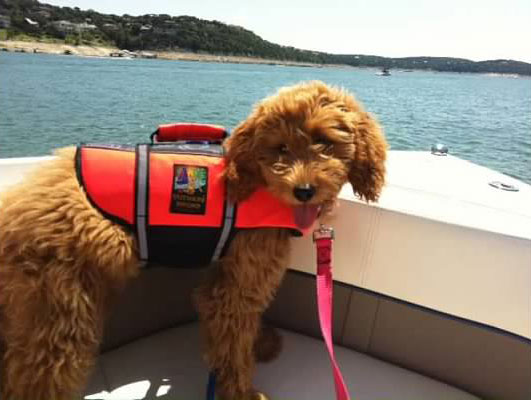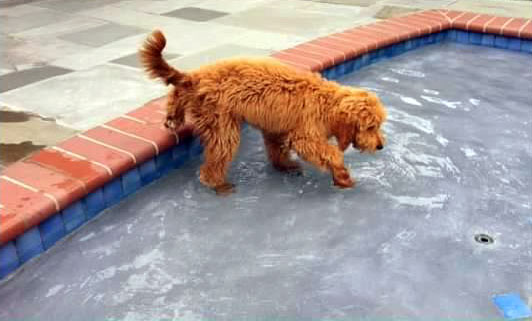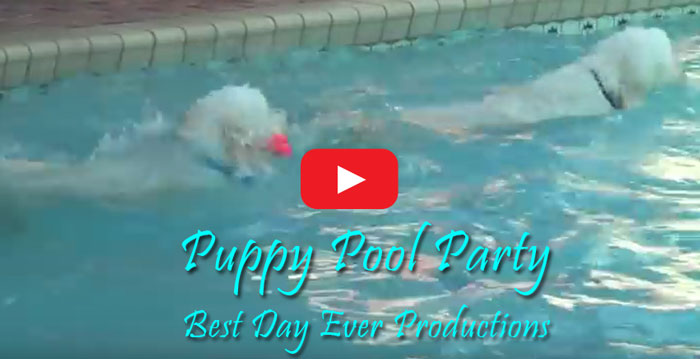Pool and Water Safety
Many Goldendoodles enjoy swimming as much as people do, and cool times in the local swimming spot or backyard pool are one of the best parts of summer. But you have to look out for your Goldendoodle puppy around water, since even the strongest, most enthusiastic swimmers can get into trouble.
The keys to water safety for dogs: prevention, preparedness and awareness.
Watch our video to see some of our Goldendoodles having the "Best Day Ever" Pool Party!
Prevention
No dog should be given unsupervised access to a backyard pool or a neighborhood pond or creek. Swimming pools are best fenced off for safety. And if that's not possible, they should be equipped with alarms that sound when the surface of the water is broken by a child or pet falling in. Escape tools like the Skamper-Ramp (www.skamper-ramp.com; 1-877-766-5738) are a good idea, but it's better to prevent pets from getting in unsupervised in the first place.
Prevention also includes teaching your pet what to do when he/she's in the pool. Dogs don't get the idea that the steps are on one side only, and they may tire and drown trying to crawl out the side. If your pet likes to swim, work with him/her in the pool to help them learn where the steps are so he/she can get out easily. Most puppies/dogs can swim but they cannot find their way out of a pool. Get in with your puppy and teach him/her where the steps are and how to get out.
Finally, obedience training is extremely important. Your dog should come when called, even when swimming, so you can call him/her back before the dog heads into deeper water or stronger currents. Emergency shortcut: Always carry extra retrieving toys. A dog who's heading out into a dangerous area after a ball or stick can often be lured back into shore with a second item thrown closer in. It's no substitute for training, but it could save your dog's life.
Preparedness

Before letting your dog swim in any natural surroundings, survey the area for safety. Rivers and oceans can change frequently, and an area that was safe for swimming one visit can be treacherous the next. Consider currents, tides, underwater hazards and even the condition of the water. In the late summer, algae scum on the top of standing water can be toxic, producing substances that can kill a pet who swallows the tainted water.
When in doubt, no swimming. Better safe than sorry.
One of the best things you can do is take courses in first aid and CPR for your pets. Many local Red Cross chapters offer these classes, and some veterinarians may also teach them in your community. A dog who's pulled out near death from drowning may be saved by your prompt actions -- if you know what to do.
If your dog isn't much of a swimmer, or is older or debilitated, get him a personal floatation device. These are especially great for family boating trips because most have sturdy handles for rescue when a pet goes overboard.
Awareness
Be aware of your dog's condition as he/she plays. Remember that even swimming dogs can get hot, so bring fresh water and offer it constantly. When your dog is tiring, be sure to call it a day. A tired dog is a good dog, but an exhausted dog is in danger of drowning.
Be particularly careful of young and old dogs. Both can get themselves into more trouble when a healthy adult dog with lots of swimming experience. Young dogs can panic in the water, and old dogs may not realize they aren't as strong as they used to be. Keep them close to shore, and keep swimming sessions short.
Swimming is great exercise and great fun for all, and with these few simple precautions you can keep the cool times coming, with safety in mind.
PERFECT POOL PLAY IN A SMALL WAY
Just as it seems that as many "baby" gates are purchased for pets as for children, the ubiquitous kiddie pool has thoroughly gone to the dogs.
The small pools made of hard plastic are perfect for dogs of all sizes, providing a tummy-cooling wallow for an overheated retriever or a safe way to wade for a swim-challenged pug. (Be sure to choose the hard-plastic variety; the inflatable kind doesn't hold up well to dog claws.)
Always supervise the pool's use, to prevent any accidents.
Kept clean and stored in a covered spot for winter, a kiddie pool will last for many seasons. Just remember in the summer that standing water is a perfect breeding ground for mosquitoes and toxic algae, so rinse it clean after every use and refill it with fresh water every time.










